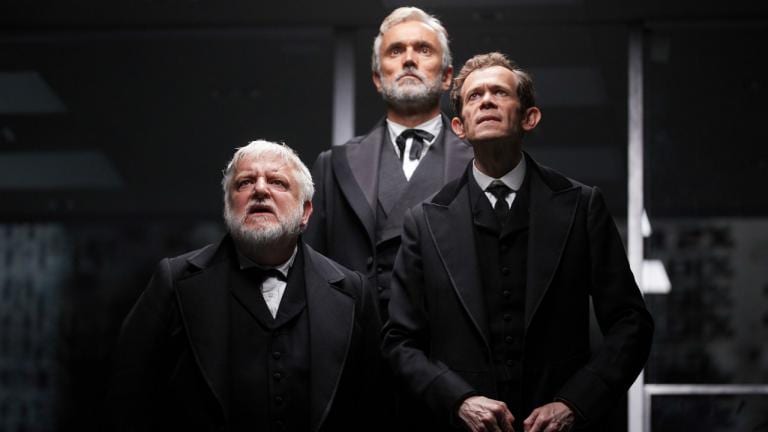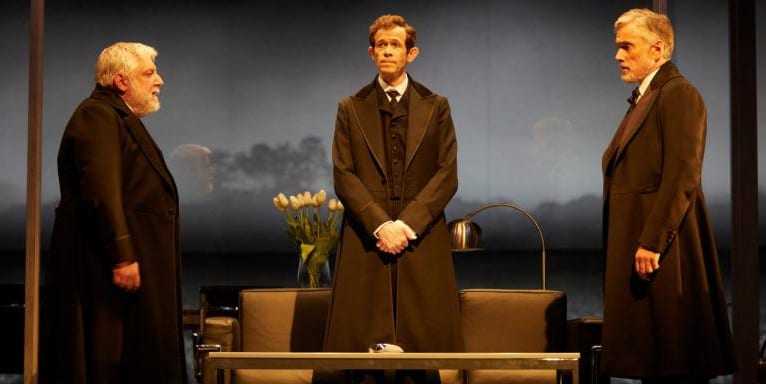Three brothers, in three acts, and spread over three generations: this is the pattern for Ben Power’s adaptation of Stefano Massini’s sprawling account of the rise and fall of Lehman Brothers from its foundation in 1844 to the closure we all know about in 2008.

In various formats this work has had great success in Europe, and it is easy to see why. It is an engrossing dynastic saga peopled by highly contrasted characters, also offering a commentary, even at points a deep parable, on the development of American capitalism. However, like many long-distance sagas it has a problem in finding the right ending.
We first see Haim/Henry Lehman (Simon Russell Beale) arrive with a suitcase to greet ‘the magical music box that is America’. Followed by his younger brothers Emanuel (Ben Miles) and Mayer (Adam Godley), they begin by setting up a general store in the South and expand their operations through the adept seizing of opportunities born of calamity. They become cotton trade middle-men negotiating the perils of the Civil War, before moving their operations to New York and diversifying into coffee and banking. We then follow the family into the next two generations, with the same three actors playing all the characters. The company moves away from trading in goods into the investing of money in new capitalist ventures: trains, planes or even movies such as ‘King Kong’.
A fatal shift comes with the creation of an independent financial trading division in the 1960s from which the sub-prime hubris ultimately flows. But at this point the family connection has faded away, and we are talking about a very different kind of company. This is the stage at which telling suddenly takes over from showing. The two have been in perfect balance until this point, where there is a rush of information and new characters that are ill-considered by comparison. While we do finally reach 2008, the links between the company the family nurtured and the firm that failed under other owners are tenuous, and the portrait of American capitalism that has been so nuanced up until 1945 becomes sketchy, thin and suddenly unconvincing.
But for most of the journey both creative direction and acting quality are masterly. Es Devlin’s set is a glass and chrome revolve evoking the last Lehman Bros. building. It is sub-divided and populated with contemporary tables, chairs and cardboard boxes that are inventively rearranged throughout the evening. However, the actors remain dressed in sober-suited nineteenth-century dress throughout. Evocative video backdrops by Luke Halls provide a shifting portrait of plantation and factory and urbanisation which gives a chronological anchor; and Candida Caldicot’s almost-continuous piano accompaniment lends a deft underscore to mood, time and place.

However, the joy of the evening resides in the exquisite variety and layering of the acting by the three main players. They first of all establish the individual characters of the three brothers, one the head, the other the arm, and the last the mediator and force for reconciliation between the first two. But they then proceed to feed our imaginations with a series of delightful and humorous cameos, as friends, wives, rabbis, tradesmen and rivals. So although what we see in front of us does not change, we feel the texture of time’s passage in telling detail. The same is true of the later generations, equally well punctuated by quirks and obsessions and fearsome anxiety dreams.
Key conflicts between priorities are enacted and worked through, and ethical challenges and choices fully and fairly explored. Above all the handling of the Judaism of the family is delicately achieved: we see how important the mesh between faith and work is in the early years, and how it is gradually eroded as rituals lose their salience and moral vigour. The approach is realistic but with surreal, symbolic moments too, as a breeze blows through the room at crucial turning points in business strategy or personal commitment.
This is an engrossing evening of superlative five-star acting in a play that is of equal quality for three quarters of its length. Like the tightrope walk that forms a symbolic part of the action, it’s truly awe-inspiring until the artist wobbles and falls in the final half hour.

